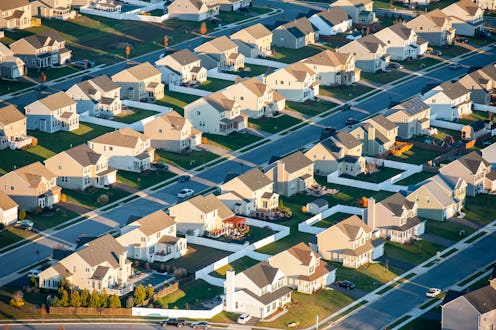Before You Move
The Pros & Cons Of New Builds vs. Old Homes
Including the legal obligation to declare ghosts.
by Kaitlyn Wylde
Updated:
Originally Published:

In How To Move To The Suburbs, Bustle breaks down the challenges and joys of leaving the city in a step-by-step process. In this installment, Kaitlyn Wylde unpacks the four main decisions you need to make once you’ve decided to relocate: commuter towns vs. rural neighborhoods, moving home vs. moving somewhere new, renting vs. buying, and in this column, new build houses vs. old homes.
New Builds
The Pros
- Permits were issued for 1,589,000 new privately-owned homes to be built in September 2021. This figure is fairly consistent with September 2020, which means there are lots of great new homes to choose from.
- In these new properties, you don’t need to worry about lead, asbestos, or, you know, ghosts. Plus, they can be more energy efficient.
- You may be able to customize the interiors as it’s being built.
Tip: Look out for the Energy Star certification, which indicates that a property has met EPA guidelines for energy efficiency. In 2019, the New York Times reported that homes built following this criteria “saved over $20.3 million in electric bills and reduced CO2 emissions by 107,303 metric tons, the equivalent of 23,209 cars, 249,713 barrels of oil, or the CO2 captured by 1.77 million trees grown from seedlings for 10 years.”
The Cons
- We need to build new houses because of increased demand, right? Sort of. In August 2021, there were 1.29 million units for sale, down 13% from August 2020. But one analyst told CNBC that the lack of supply is a blip, and that the “downward trajectory of population growth [and] household formation” means we’re overbuilding, which is bad for the environment.
- Beware of cheaper, lower-quality materials used to cut costs; and even so, new homes can still be 30% more expensive to buy than existing homes.
- Land is growing scarcer in the suburbs, so new builds often have smaller outdoor spaces.
Tried It & Liked It
“I love my new house because it was made thoughtfully. For example, there are lights everywhere — under the cabinets, in the closets — and the open flow of the house makes sense for modern life and entertaining. Being able to move in and not worry about fixing floors or finding old damages that were disguised for the sale is a huge relief. We’re not just waiting for the other shoe to drop as we were when we lived in an older house before.” – Molly, 32, graphic designer in Connecticut
Old Properties
The Pros
- Character! Personality! Charm!
- Established landscaping, so you don’t have to take a square box of grass and jazz it up.
- Built-in relationship with neighbors and community.
Tip: Make sure you do a thorough budget. In 2019, the last year of pre-pandemic construction, the average American spent $13,000 on a renovation, with the National Association of Home Builders advising that you base your spending on a percentage of the house’s total value.
The Cons
- If you’ve ever heard an old house referred to as a “money pit,” you know that unexpected costs of renovation and repairs can be a problem.
- Complicated baggage including water damage, mold, or rotting trees.
- Ghosts (which your seller may be legally obligated to disclose).
Tried It & Liked It
“I love my old house because I felt like I was instantly welcomed into the community. By moving into a house that was already there, I didn’t have to worry about shaking anything up. It’s also fun to learn about the quirks of the house. It makes it so much more interesting to discover choices that were made in another time.” – Gregg, 28, nurse in North Carolina
Interviews have been edited and condensed for clarity.
This article was originally published on